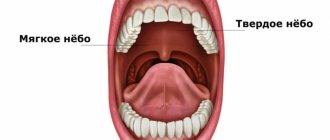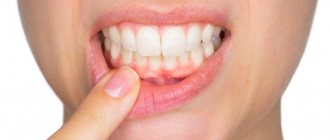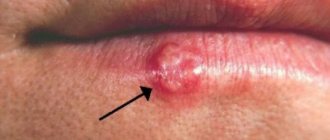Causes of a rash on the mucous membrane
In fact, there are many of them, ranging from the most harmless to the very dangerous. Let's look at each of the reasons in order.
Injury or burn of the mucous membrane
If a bubble appears on the gum, its appearance may be due to eating too hot food, drinks, or injury to soft tissues (for example, you bit them with your teeth while chewing food or falling). Various traditional methods of treatment can also pose a traumatic threat to the delicate mucosa. For example, using garlic or hydrogen peroxide can cause a burn. A bad habit such as smoking can also provoke the appearance of a rash on the mucous membrane, because when using cigarettes, the delicate mucous membrane constantly gets burned.
Soft tissues can be injured by incorrectly installed dentures or overhanging fillings, or incorrectly selected toothbrushes with hard bristles. A bubble with liquid on the gum may also appear due to an incorrect bite, because... in this case, you will again systematically damage the mucous membrane, and bacteria will begin to penetrate into the damaged tissue.
On a note! Injuries to the mucous membrane can lead to the appearance of a lipoma or wen in the mouth. This benign neoplasm occurs in the oral cavity quite rarely and causes mainly cosmetic problems. However, the wen tends to grow, which can lead to discomfort when opening the mouth and eating food.
Allergic reaction
Allergies can occur to various foods, medications, and personal hygiene products.
Dental diseases
Caries, pulpitis, periodontitis - these diseases, in the absence of timely treatment, progress and can lead to the formation of an inflammatory process at the apex of the tooth root and surrounding tissues, which in turn will provoke the appearance of purulent blisters on the gums. The presence of blisters in this case may indicate a gumboil, abscess, or fistula.
However, a purulent blister on the gum can appear even if you have your teeth treated by a dentist in a timely manner, fillings and crowns are placed. A problem may arise if the doctor did not properly disinfect and seal the root canals of the diseased tooth.
“After I had sinusitis, my gums ached and my tooth hurt, but there were no blisters or even redness on it, no caries or “holes.” Therefore, I did not go to the doctor for a whole year, until I felt that the tooth was loose and would soon begin to fall out. Then I went to the dentist, it turned out that I had a huge cyst at the root, which contained pus. The tooth had to be removed!”
Varvara Tm, from correspondence on the woman.ru forum
Sometimes pathology occurs in patients who have recently had a tooth removed. In this case, the blister may appear due to violation of aseptic rules during the removal procedure or due to the fact that the patient himself did not care about maintaining thorough oral hygiene during the rehabilitation process.
Infectious and viral diseases
You should always remember that the oral cavity is an excellent environment for the growth of bacteria, because... here the temperature, humidity, and also “food” are suitable for them. Bacteria can enter the oral cavity through the mouth when talking and eating, or through the nasopharynx. With a banal weakening of general or local immunity and insufficiently good oral hygiene, they easily occupy the teeth, gums, mucous membranes of the cheeks, palate, and trigger the inflammatory process. Therefore, if a bubble is inflated on the gum or a lot of them appear, then, most likely, the phenomenon is associated precisely with the predominance of pathogenic microflora over the beneficial one, and with the development of the following pathologies:
- activation of the herpes virus: in 50% of all cases, the appearance of water blisters on the gums is associated with herpes. It “dormants” in the body of 90% of all people on the planet, and under the influence of unfavorable factors (weakened immunity), it is activated,
- pemphigus: the etiology of the disease has not yet been fully elucidated, but scientists believe that it occurs when the immune system is weakened, and often appears as a complication against the background of tonsillitis, tonsillitis or influenza, oncology and chemotherapy. Also, its development can be triggered by a violation of autoimmune processes in the body. The pathology is diagnosed mainly in women aged 40-60 years1,
- herpes zoster or lichen planus: with this disease, a white bubble or neoplasm with transparent contents may appear on the gum,
- sore throat or diphtheria,
- stomatitis.
General diseases of the body
We can talk about autoimmune diseases, for example, HIV or AIDS, hepatitis, tuberculosis or syphilis, cancer. Problems with the gastrointestinal tract, thyroid gland, liver and kidneys can contribute to the appearance of a rash on the mucous membrane.
People with heart pathologies also develop tumors in the oral cavity. For example, with hypertension and damage to the blood vessels on the mucous membrane of the palate, the inside of the cheeks and the mouth, single hemorrhagic blisters2 bluish in color with bloody contents can form.
Preventive actions
Monitoring the condition of the teeth and oral cavity will reduce the likelihood of tumors.
- Timely sanitation of the oral cavity. Visiting the dentist for a preventive examination and professional hygiene twice a year will prevent the growth of caries, the appearance of defects in fillings and the formation of tartar, leading to gum injury and the appearance of epulis.
- Prevention of gum injury. If systematic injury to soft tissue occurs as a result of poorly fitted orthopedic or orthodontic structures, consult your doctor about this problem. He will adjust the crowns or dentures.
If these preventive measures are followed, the prognosis is favorable and epulis does not recur.
We hope that our article about epulis will be for informational purposes only. And if you want to soothe your gums, make them strong and strong, try the unique two-component mouth rinse ASEPTA ACTIVE.
This is the only rinse with a combination of chlorhexidine + benzydamine for the treatment of inflammatory periodontal diseases. The product has a combined effect: antimicrobial, anti-inflammatory and analgesic. Instant anesthetic effect allows you to quickly reduce pain.
If a rash appears in a child
Of course, in most cases, a bubble appears on a child’s gum for the same reasons as in an adult. But there are specific diseases that most often occur in children (they can also appear in adults, but much less frequently):
- chickenpox: it’s good if the baby gets chickenpox before he goes to school, because at a later age or in adulthood, this “childhood” disease is much more difficult to tolerate. Chickenpox is characterized by rashes all over the body, including transparent blisters that may appear on the gums or mucous membranes,
- candidiasis: with thrush, blisters appear on the gums and mucous membranes, and a thick, cheesy coating forms. This disease often occurs in newborns or children under 2-3 years of age, because they have not yet developed immunity,
- “Epstein's pearls”: a white bubble on the palate of a newborn does not indicate the presence of a serious pathology. Pediatric neonatologists urge parents not to worry about this, because After a few weeks the phenomenon goes away on its own. However, to make an accurate diagnosis, you need to visit a dentist or pediatrician,
- measles: at first, measles resembles a cold, the patient’s body temperature rises, and then a rash appears in the mouth, resembling semolina in appearance,
- scarlet fever,
- rubella.
On a note! A red bubble on the gum may appear in a child during the eruption of baby teeth. Such a neoplasm often occurs during the eruption of molars or incisors. It is red because it is filled with ichor.
A bubble in the mouth on the gum of a child is a reason not only to see a doctor, but also to strengthen general hygiene and oral hygiene. Remember that young children often try to put household items and toys into their mouths, and any bacteria from them can cause the development of an inflammatory process and complicate the course of the underlying disease.
Clinical researches
Repeated clinical studies have proven that the two-component mouth rinse ASEPTA ACTIVE more effectively combats the causes of inflammation and bleeding compared to single-component rinses - it reduces inflammation by 41% and reduces bleeding gums by 43%.
Sources:
- Clinical and laboratory assessment of the influence of domestic therapeutic and prophylactic toothpaste based on plant extracts on the condition of the oral cavity in patients with simple marginal gingivitis. Doctor of Medical Sciences, Professor Elovikova T.M.1, Candidate of Chemical Sciences, Associate Professor Ermishina E.Yu. 2, Doctor of Technical Sciences Associate Professor Belokonova N.A. 2 Department of Therapeutic Dentistry USMU1, Department of General Chemistry USMU2
- The effectiveness of the use of Asept “adhesive balm” and Asept “gel with propolis” in the treatment of chronic generalized periodontitis and gingivitis in the acute stage (Municipal Dental Clinic No. 4, Bryansk, Kaminskaya T. M. Head of the therapeutic department Kaminskaya Tatyana Mikhailovna MUZ City Dental Clinic No. 4, Bryansk
- Study of the clinical effectiveness of treatment and prophylactic agents of the Asepta line in the treatment of inflammatory periodontal diseases (A.I. Grudyanov, I.Yu. Aleksandrovskaya, V.Yu. Korzunina) A.I. GRUDYANOV, Doctor of Medical Sciences, Prof., Head of Department I.Yu. ALEXANDROVSKAYA, Ph.D. V.Yu. KORZUNINA, asp. Department of Periodontology, Central Research Institute of Dentistry and Maxillofacial Surgery, Rosmedtekhnologii, Moscow
- The role of anti-inflammatory rinse in the treatment of periodontal diseases (L.Yu. Orekhova, A.A. Leontyev, S.B. Ulitovsky) L.Yu. OREKHOVA, Doctor of Medical Sciences, Prof., Head of Department; A.A. LEONTIEV, dentist; S.B. ULITOVSKY, Doctor of Medical Sciences, Prof. Department of Therapeutic Dentistry of St. Petersburg State Medical University named after. acad. I. P. Pavlova
How to determine the cause of problems by the type of rash
| Type of rash | Pathology | Other characteristic signs |
| A small, clear rash that causes severe itching and burning | Allergy | Discomfort usually improves with antihistamines. |
| A single bubble with clear liquid has inflated on the gum | Burn or injury | There will be noticeable redness and swelling of the mucous membrane around the bubble. The damaged area will “burn”, and the pain will be constant and aching. |
| Blood blister on the gum | Infection or pathologies of internal organs | Accompanied by an increase in body temperature, enlarged lymph nodes, and a general deterioration in health. |
| A purulent or white bubble on the gum near the tooth | Advanced dental disease | Pain when pressing on the tooth, swelling of the mucous membrane around the diseased tooth. Presence of a carious cavity or filling. The causative tooth may become loose. |
| Bubbles not only on the mucous membrane, but throughout the body | Pemphigus or chickenpox, measles, rubella, scarlet fever | After a while, the bubbles burst, and in their place wounds form, which then gradually heal. |
| Small blisters on the gums, on the inside of the mucous membranes of the lips and cheeks | Candidiasis or stomatitis | Accompanied by the appearance of a whitish coating on the tongue. The ulcers heal poorly, hurt, and make you refuse to eat. Burning, dryness and itching of the mucous membrane appear. |
Important! There are situations when a bubble in the mouth, for example, a fistula, opens on its own, making the person immediately feel better. However, this phenomenon is deceptive, and should not be a reason for you to postpone a visit to the doctor. Breakthrough of the tumor and release of purulent contents can cause intoxication of the body and blood poisoning.
Varieties of epulis
Conventionally, there are 3 types of epulis:
- Fibrous. The neoplasm is dense, the basis is coarse fibrous tissue. Characterized by slow growth. There is no pain or bleeding.
- Angiomatous. The tumor contains a large number of blood vessels and is localized mainly in the lateral parts of the jaw. With this form of the disease, bleeding is observed even with slight pressure, for example, with a toothbrush or food. When pressed, the tumor is painless and has a soft consistency.
- Giant cell. The tumor can reach large sizes, displacing teeth that are located in the epulis growth zone. The mucous membrane of the epulis is bluish-red in color. On palpation, the neoplasm is painless, but may bleed moderately if injured.
Depending on the nature of the process, epulis can be benign or malignant. In the first case, the neoplasm is characterized by slow development and, as mentioned above, in most cases does not cause pain. The tumor size in this case rarely exceeds 10–20 mm. When the process becomes malignant, rapid tissue growth is observed. In this case, the process is often accompanied by pain, bleeding gums and affects the root canals of neighboring teeth.
First aid at home: do's and don'ts
What can you do
A bubble on the gum of an adult or a child in most cases “signals” the presence of some kind of disease. Therefore, there is no need to think about how to remove it yourself - this should be done by a doctor. However, before you see a specialist, who will make an accurate diagnosis and prescribe treatment procedures, you can alleviate the condition and prevent the infection from spreading throughout the body.
If there are painful sensations, then a cold compress (apply only on the outside of the cheek, after wrapping the cold compress in a soft towel or cloth) and taking analgesics will help get rid of them. To disinfect the oral cavity, you need to use rinses based on a decoction of herbs, soda and salt. For rinsing, you can use Miramistin and Furacilin.
What not to do
You should not use antibiotics without consulting a doctor. Also, under no circumstances should you heat the painful area, because such actions will only aggravate your situation, causing the rapid spread of infection throughout the body.
You cannot open a bubble on your gum yourself. You cannot treat it with brilliant green, iodine or potassium permanganate, alcohol tinctures, propolis, because this can lead to injury and burns of the mucous membrane, and an allergic reaction.
Folk remedies
The use of effective folk methods and recipes as a supplement to basic drug treatment can significantly speed up the healing process.
- Rinse with saline solutions. Per liter of boiled water - 4 tbsp. spoons of salt, leave to brew for an hour. Afterwards, warm the solution a little and sanitize the oral cavity. Salt disinfects, relieves swelling, and soothes.
- Gargling with herbal infusions. Chamomile, eucalyptus, calendula, and yarrow are suitable for these purposes. 4 tbsp. l. herbs are brewed in 1 liter of boiling water and infused for half an hour. Herbs have a calming and antiseptic effect on the mucous membrane and promote the resorption of compactions.
- Kalanchoe juice. Nourishes and heals inflamed gum tissue, strengthens tooth enamel. Freshly squeezed juice is rubbed into the gums, or a washed leaf, freed from the outer skin, is simply chewed.
- Salt with honey. Healing tandem - salt softens inflamed tissues and helps remove purulent exudate, and honey disinfects, nourishes, and soothes. A mixture of honey and salt is prepared in a 2:1 ratio.
- Garlic tincture. It removes pus well and is a powerful antiseptic, but to avoid burns it should not be used for more than 3 days. The infusion is prepared from 4 heads of garlic, 5 lemons and 700 grams of vodka. The crushed ingredients are infused in alcohol for 3 days. Then rinse the mouth with the solution every 4 hours.
Important! Traditional methods are auxiliary methods of combating the disease, not a panacea, and will not replace drug treatment prescribed by a dentist.
What to do if a blister appears due to a burn or injury
If a bubble filled with clear liquid swells on the gum, then you need to know how to act correctly.
Firstly, you cannot open it yourself, because... then bacteria from saliva will penetrate into the open wound, and the inflammatory process will begin. And your main task is to ensure sterility of the neoplasm and promote rapid healing of soft tissues. To do this, you can apply compresses with Solcoseryl or Metrogyl Denta gel to the damaged area. You can lubricate the mucous membrane with aloe juice or sea buckthorn oil.
Secondly, while the damaged tissues are healing, try not to eat “irritating” foods (sour, spicy, hard, hot and cold).
Important! If the bubble opens without your help, then ensure it is sterile. To prevent infection from entering the wound, rinse your mouth after each meal with a soda solution or chamomile. The damaged area can be treated with Levomekol or Cholisal for speedy tissue regeneration.
Treatment for infectious diseases
Here, as with burns and injuries, you can’t do it on your own. You first need to see a doctor who will determine the type of disease and prescribe treatment. For example, for measles, herpes, candidiasis or stomatitis, treatment should be comprehensive:
- taking antiviral drugs,
- antifungal drugs,
- antiseptic treatment of the oral cavity,
- the use of local ointments,
- vitamin therapy: you need to strengthen the body from the inside to increase its resistance to bacterial attack,
- painkillers,
- diet correction,
- strengthening oral hygiene.
We deliberately do not list the names of drugs, because... For different infectious diseases, different medications will be effective, and only a doctor can determine the true cause of the pathology.
What kind of help will the dentist provide?
If the cause of the appearance of a white bubble on the gum of a child or adult is an advanced dental disease, then the main tasks of the dentist are:
- disinfect the source of infection and prevent the spread of pus to neighboring areas and tissues,
- cure the root canals of a diseased tooth,
- save the tooth from removal.
With this pathology, the doctor opens the abscess and drains it, then cleans the root canals and puts a filling. However, in advanced stages of the disease, it will not be possible to do without an extraction procedure (tooth removal). Delay is especially dangerous for baby teeth, because... underneath them are the rudiments of permanent ones. Therefore, when a fistula, cyst or flux appears, in most cases the milk unit must be removed so that the infectious process does not cause pathologies in the formation of a permanent bite.
Associated symptoms
The characteristic accompanying symptoms directly depend on the specific type of problem and the cause that caused it. So, for example, a periodontal abscess causes acute painful sensations when pressed and any other mechanical irritation. In this case, the causative tooth may wobble a little, which is due to an increase in the volume of purulent exudate and its attempt to get out.
Under such circumstances, a person usually experiences a general loss of strength, and the body temperature may rise. Sometimes the abscess opens on its own, and then the new growth on the gum will gradually disappear without outside help. But this situation is very dangerous, because pus can lead to infection and intoxication of the body, so if a suspicious lump appears on the mucous membrane, you should urgently run to the dentist.
What happens if you don't get treatment?
A bubble on the upper or lower gum cannot be ignored. If the cause of its appearance is a fungus or herpes, then after a while the entire oral mucosa may become covered with blisters, which will cause pain and prevent you from fully eating food.
In the presence of untreated dental diseases, due to which a bubble with pus appears on the gum near the diseased tooth, the infection will primarily affect the root and surrounding tissues, spreading to neighboring units. This situation may lead to the need to remove teeth. If a cyst, abscess, fistula, flux occurs, pus through the bloodstream can spread to internal organs and even reach the brain, leading to sepsis, osteomyelitis, jaw fracture and death.
Lump after crown installation
Improper denture fitting is a very common cause of lumps on the gums. Most often, errors occur at the tooth preparation stage, when the depulpation procedure is carried out. Poor canal filling provokes the development of infection, which, in turn, leads to periodontitis. Another common reason is a poorly made prosthesis or defects during its installation. In this case, the prosthesis injures the mucous membrane and causes swelling, abscesses and growths. Treatment almost always involves removal of the prosthesis and subsequent replacement of the prosthesis (if possible). The sooner a complication is detected, the higher the chance that it can be successfully treated. A well-installed prosthesis should not cause pain, discomfort or injure the mucous membrane. The tooth under the crown should also not hurt, since the dental nerve is killed before permanent prosthetics.










